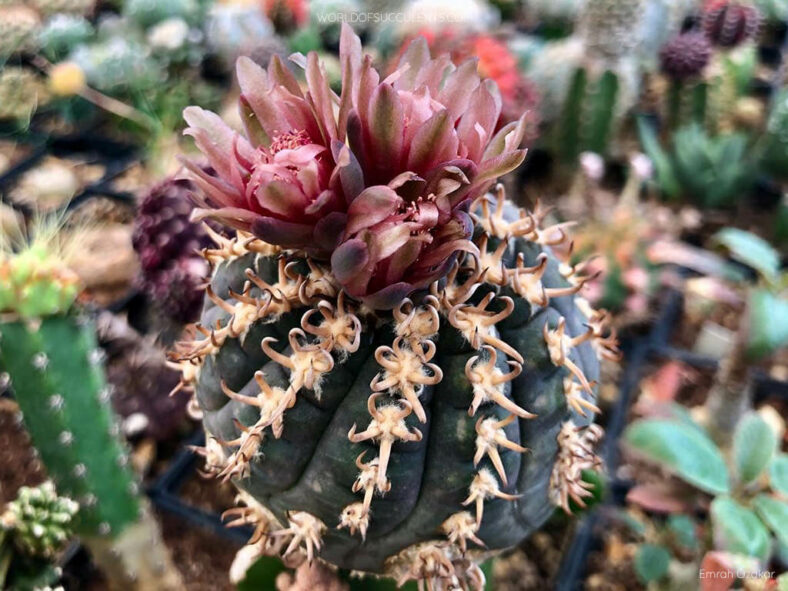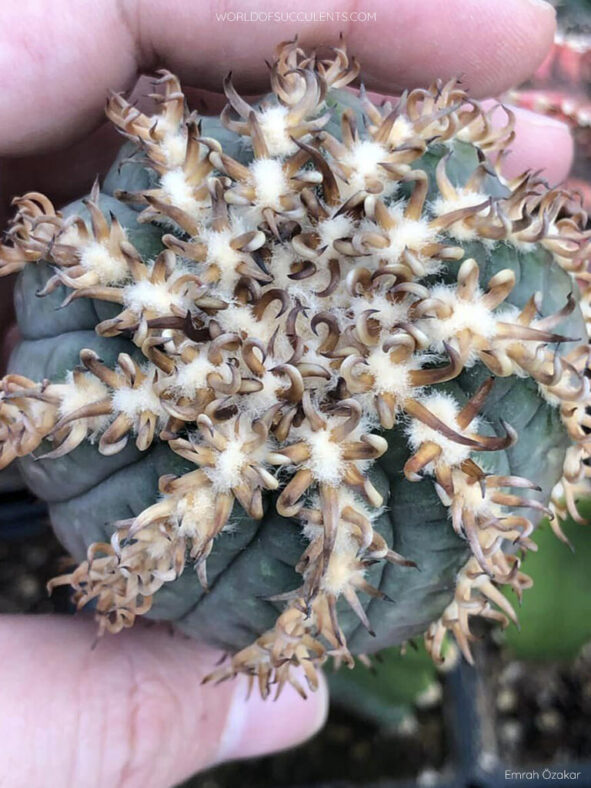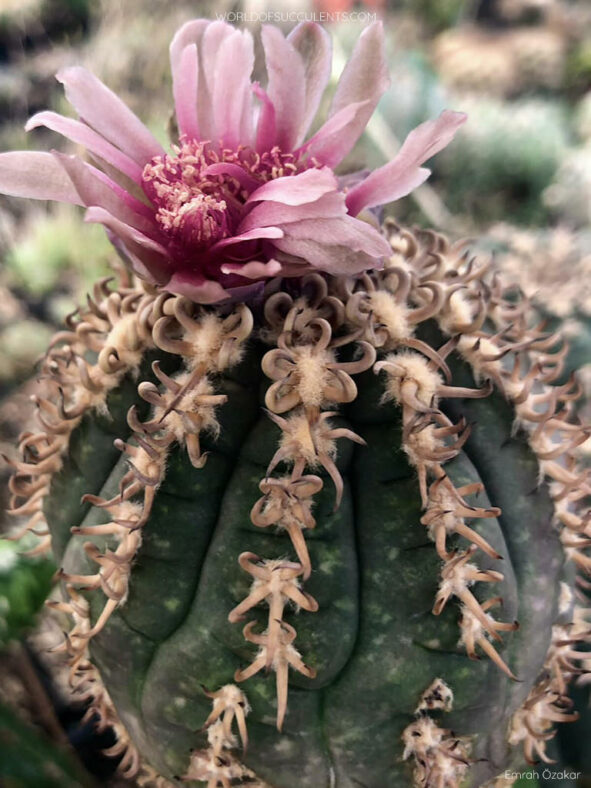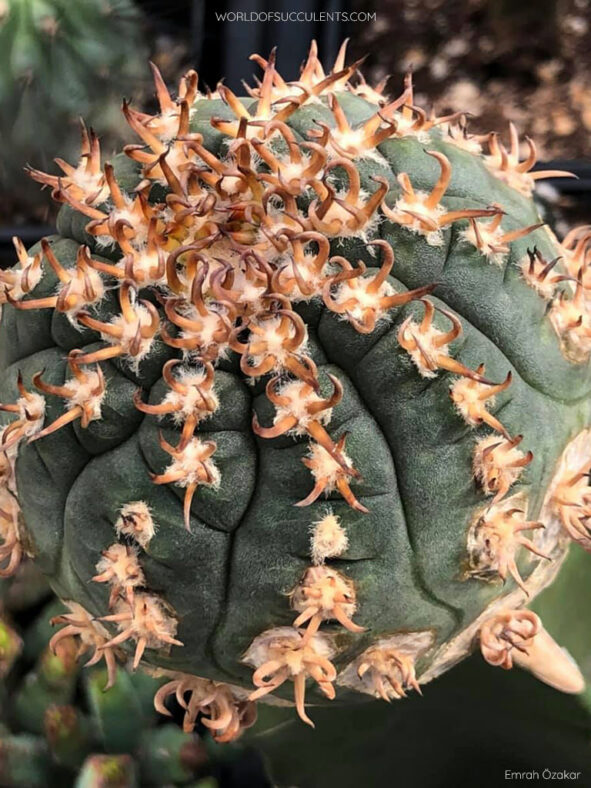Gymnocalycium spegazzinii f. unguispinum is slow-growing on its own roots, so it is commonly grafted onto a more robust species that accelerates its growth rate.
Scientific Name
Gymnocalycium spegazzinii f. unguispinum Slaba
Accepted Scientific Name
Gymnocalycium spegazzinii Britton & Rose
Synonym(s)
Gymnocalycium spegazzinii var. unguispinum
Scientific Classification
Family: Cactaceae
Subfamily: Cactoideae
Tribe: Trichocereeae
Genus: Gymnocalycium
Etymology
The formal epithet "unguispinum (pronounced un-gwee-SPIN-um)" means "with claw-like spines" and refers to the shape of the spines.
Origin
Gymnocalycium spegazzinii f. unguispinum is not recognized as a separate form, and it is listed as a synonym of Gymnocalycium spegazzinii subsp. spegazzinii. It was collected south of Puerta Tastil, a hamlet in the Salta province in northwestern Argentina.
Description
Gymnocalycium spegazzinii f. unguispinum is a small and cute cactus with a gray-green to brownish stem with usually ten wide ribs lined with woolly areoles that bear a cluster of stout spines. It is distinguished from the typical form by its much shorter spines, usually less than 0.4 inches (1 cm) long. The stem is spherical with a woolly, somewhat sunken apex and can grow up to 4.8 inches (12 cm) tall and 8 inches (20 cm) in diameter. The spines are typically pointed downwards, curved, and adpressed towards the stem. Each areole bears 5 to 9 radial spines, while the central spines are absent.
The funnel-shaped flowers appear from the areoles near the apex of the stem in late spring and last for about two weeks. They can reach up to 2.8 inches (7 cm) in length and 2 inches (5 cm) in diameter. The outer tepals are whitish to rosy with an olive-green midstripe, while the smaller inner tepals are white with a pink midstripe and a carmine base. The fruits are oblong and can grow up to 1.4 inches (3.5 cm) long. They are powdery blue with a few rounded scales and contain tiny, dark brown to black seeds.

How to Grow and Care for Gymnocalycium spegazzinii f. unguispinum
Light: This cactus needs some protection from direct sunlight during the hottest months. However, excessive shading will result in the loss of flowers.
Soil: Having soil with good drainage is most important for a healthy Gymnocalycium spegazzinii f. unguispinum. You can use commercial soil for cacti or make your own mix.
Temperature: This cactus can tolerate high temperatures but is not a cold-hardy plant. So, if there is a risk of freezing temperatures, bring it indoors. It grows best in USDA Plant Hardiness Zones 9b to 11b, with average minimum winter temperatures ranging from 25 to 50 °F (-3.9 to 10 °C).
Watering: During the growing season, water Gymnocalycium spegazzinii f. unguispinum frequently, but allow the soil to completely dry out before watering again. In the winter, when it goes dormant, cut back on watering.
Fertilizing: While it does not need much fertilizing, giving it some extra nutrients occasionally keeps the plant healthy and prolongs the time for repotting. During the winter, there is no need to fertilize as the plant is not actively growing.
Repotting: Repot it every two years into a pot that is the same size or slightly larger. The best time for repotting is in late winter or early spring.
Propagation: Since it rarely produces offsets, Gymnocalycium spegazzinii f. unguispinum is usually propagated by seed. Sowing seeds in late spring or early summer is ideal.
Learn more at How to Grow and Care for Gymnocalycium.
Toxicity of Gymnocalycium spegazzinii f. unguispinum
Gymnocalycium spegazzinii f. unguispinum has no toxic effects reported. However, keep it away from pets and children as it has sharp spines.
Links
- Back to genus Gymnocalycium
- Succupedia: Browse succulents by Scientific Name, Common Name, Genus, Family, USDA Hardiness Zone, Origin, or cacti by Genus
Photo Gallery
Click on a photo to see a larger version.


